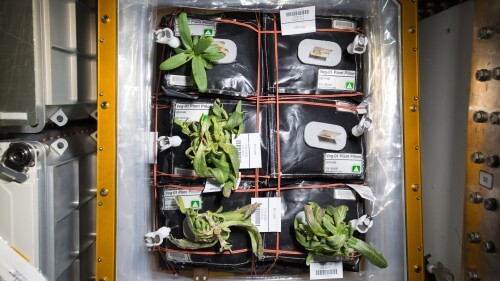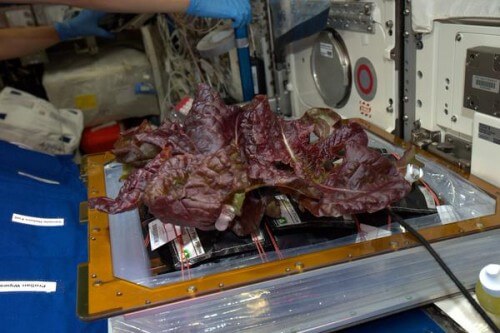
The zinnia plants growing on the "Veggie" experimental system on the International Space Station. Source: NASA.
NASA is trying to develop technology to grow plants that will provide food for astronauts during long-duration missions in space, but the zinnia plants (a type of sunflower) that it grows on the International Space Station have started to wither.
Astronaut Scott Kelly posted a photo of the wilted zinnia plants on his Twitter channel a few days ago and jokingly said that "the plants don't look very good. That would be a problem on Mars. I'll have to channel my inner Mark Watney", referring to the movie "Saving Mark Watney" released last year, in which an astronaut left alone on Mars manages to survive by growing potatoes.
According to NASA, and according to the published photo, the zinnia plants did not completely wither. The diseased parts of the plants were cut off and frozen, with the intention of returning them to Earth later for laboratory testing and to see how to prevent this in the future. NASA also stated that the cause of the wilting was a mold that damaged the zinnia plants and was made possible by humid conditions around the plants. To prevent this, Kelly increased the ventilation in the "Veggie" experimental system, where the plants grow.
The "Veggie" experiment began operating on the International Space Station in 2014, and a few months ago its first part was successfully completed, when, for the first time for American astronauts (the Russians have been doing this for a long time), romaine lettuce grown on the "Veggie" was picked and eaten by them . The current experiment is a more advanced stage of the experiment, with the intention of growing plants that will bloom flowers. As the experiment progresses, NASA plans to grow more complex plants that will produce fruit, such as tomatoes.

Growing plants in space is considered an important and essential need for a long-term stay in space, such as the future mission that NASA is planning to Mars "sometime in the 30s" as it says - such a mission will take a long time, maybe even years, due to the great distance between Earth and Mars. Growing plants will make it possible to add fresh food to the diet of the astronauts, who even today, with the station's close proximity to Earth, are mostly content with canned or vacuum-dried food, and enjoy fresh vegetables and fruits only when a supply spacecraft arrives at the station. Plants will also be able to replenish the supply of oxygen in the station's air without the need for sophisticated devices. Another major advantage is that the treatment of the plants could lift the spirits of the astronauts, who are isolated for a long time in a metal box with electronic devices and speakers that surround them from all sides.
"Vigi" is not the first experiment in growing plants in space. NASA itself began such experiments back at the Skylab space station that operated in the 70s and later on the space shuttles, and the Russians have also been doing it for many years. However, according to NASA, the current experiment is the largest "space garden" ever launched, and the first in which the plants grow in the open air of the station and not in a closed box.

4 תגובות
A question to Elisef Kussman how long have they been at the station as of today Scott Kelly and Michael Kronniko as of now no what will happen in March
Why is there no lamp for growing plants in the frame?
Amazing: this garden has been growing for 56 years inside a sealed glass bottle without air and water:
http://rotter.net/forum/scoops1/278031.shtml
An idea for NASA scientists
Too bad